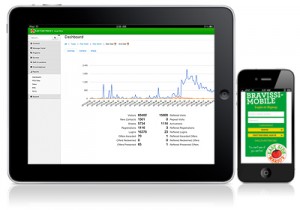I was talking the other day with Andrew Moore, Digital Marketing Manager for Prime Brands at CARA. CARA is one of Canada’s leading restaurant franchise operations, with over 800 restaurants for ten brands across the country. The company is 125 years old, and has over 26,000 employees. Andrew told me about a gamification program that he uses on the Prime Brands to drive up restaurant sales, employee productivity and motivation. It’s provided by a company called GuestEngine and the platform + mobile app are called ‘UPcell’. It shows yet another way that innovative restaurants use Maitre'D and Maitre'D data with third-party software.
If, when you hear “gamification” your first thought is Angry Birds at work, you’re on the wrong track. Gamification is about applying behavioral science to the task of managing and motivating employees. Gamified environments use ‘game-mechanics’ to motivate, engage and increase staff productivity. Game-mechanics include points, leaderboards and levels and the program operates on the principle that people become energized when there are challenges, competition and rewards in their day-to-day work environment.
The UPcell program is called ‘#Connect’ at Cara and here’s how it works:
Goals are established for each employee within each restaurant. Those goals aren’t necessarily the same for each Associate — the restaurant sales goals that are established for a trainee are different than those set for a shift lead. Employees have their own challenges, goals and rewards for achievement.
Andrew calls this an environment of cooperative competition. He means that employees are constantly trying to “win” at the game (I’ll explain what that means in a second), but they’re not trying to “beat” the other team members. They’re trying to continually achieve new personal bests. It’s not about “is A better than B,” but rather, “are A and B better than they were yesterday” (or last week or last month).
When an employee logs in to #Connect , the first thing he sees is his own dashboard, showing his current level and amount of points he’s earned to date. He also sees the daily leaderboard showing which employees are generating the largest sales for the measured period.
Every time employees achieve goals—every time they win—they’re rewarded. One of those goals is the obvious one: exceeding sales numbers for any given day. But there are other ways employees are rewarded—all of which are tightly tied to their displays of commitment and motivation. For instance, if they view training materials (an example might be supplier-provided product videos), or receive a positive review from a Guest Survey, they’re given reward points. If they refer customers, live or through social media, they’re also rewarded. As they receive more points they ‘level up’ through the game, progressing to higher levels, earning recognition, status and unlocking rewards.
Those rewards can take different forms. There are ‘virtual rewards’ such as Badges which define an accomplishment or earning a unique perk like writing your own schedule that week. And there are also “real” rewards: actual digital gift cards that can be selected from a points-based marketplace that’s integrated into the staff app.
All of the functionality that I’ve described here is, for all intents and purposes, “powered by Maitre'D data.” Maitre'D always plays well with others. Sales data, loyalty data and more are pulled in from Maitre'D to determine goals and achievements. CARA's gamification is one great example of how well Maitre'D can support innovative third party systems that drive value to the restaurant operation.

